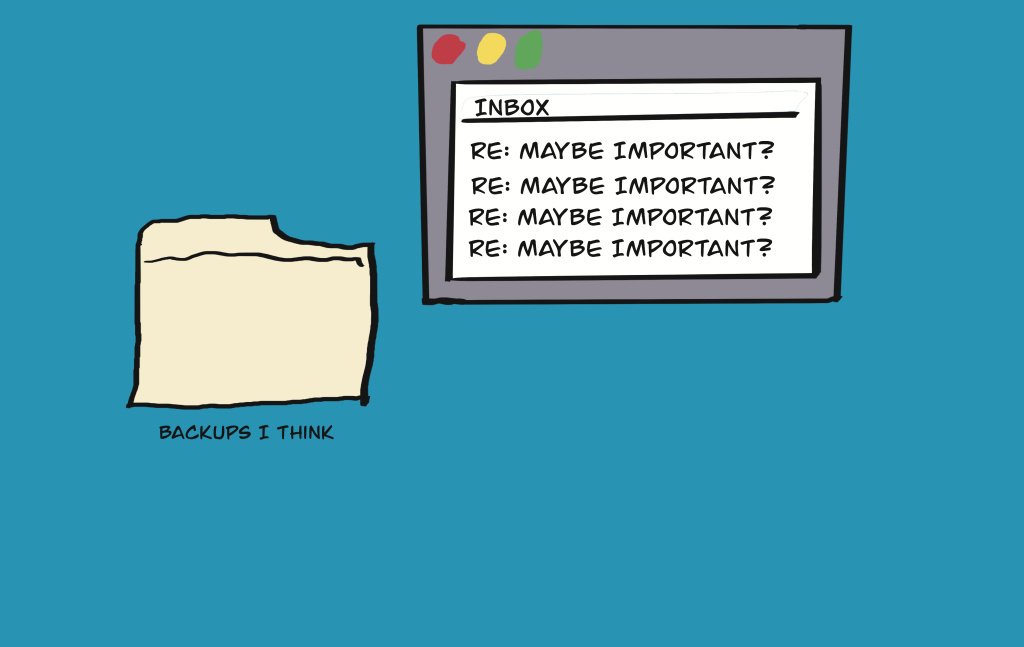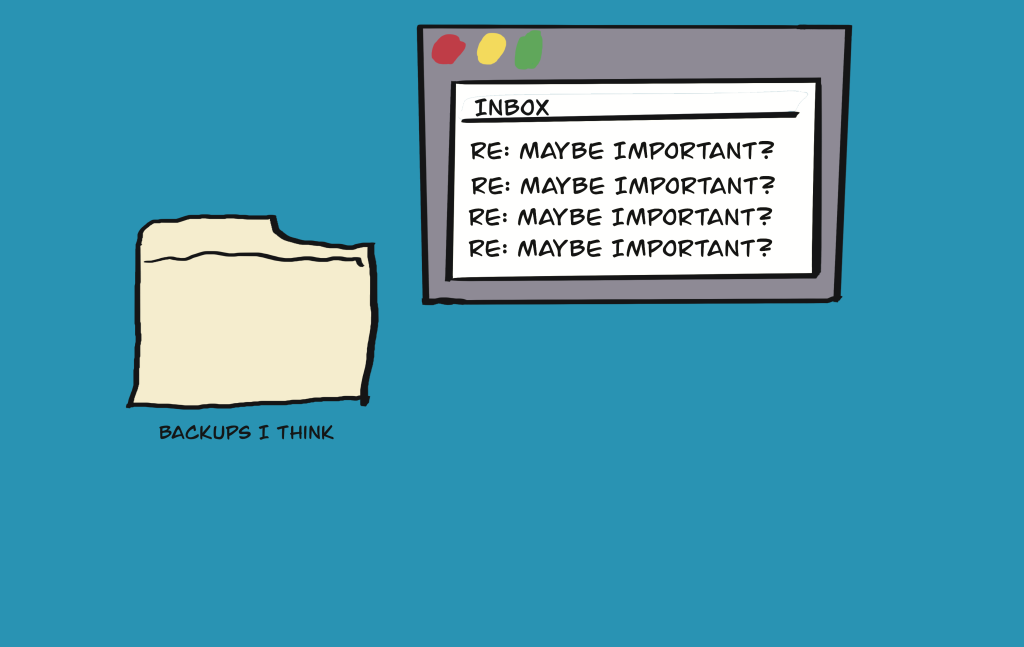Table of Contents

Innovative Backup Solution?
Dear Tech Bear,
My tech guy keeps going on about the importance of regular backups.
To save money, I’ve implemented an innovative backup solution for our small business. Every Friday, I have each employee email themselves important files with the subject line “MAYBE IMPORTANT?” Then once a month, I ask everyone to forward those emails to me, which I save in a special folder called “Backups I think.” Our efficiency is through the roof since we only back up on Fridays! Our cloud storage bill is $0! Am I a genius?
– Penny-Wise CEO
* * *

Best Practices for backups
Dear Penny-Wise,
I’m clutching my pearls over here. What you call a backup solution, I call “playing digital Russian roulette with a fully loaded revolver.”
Bless your heart, though. Your Tech Guy is right about the importance of regular backups. While I respect your commitment to financial efficiency, let’s discuss why your strategy is about as stable as a Jenga tower in an earthquake.
First, let’s talk about human error. Your backup strategy relies on employees remembering to email themselves important files. You must have some very reliable folks in your office because in most places, Brenda from Accounting can barely remember where she left her coffee, let alone which mission-critical spreadsheets need to be backed up. Relying on manual processes means at some point, someone will forget, and that someone will be the one holding the only copy of the document that keeps your business from collapsing like a house of cards.
Second, let’s discuss security. You’re backing up data by emailing it around like it’s last Friday’s office gossip. Emails are not secure. They’re about as private as a conversation in the middle of a crowded subway. If just one employee’s email gets compromised, congratulations! You’ve just handed a hacker a treasure trove of valuable business data. I hope your idea of a good time is explaining to your clients why their sensitive information is now floating around on the dark web.
Third, let’s talk about organization. Your backup folder is called “Backups I think.” Really? Really? That’s not a backup strategy. That’s a treasure hunt with no map and a high probability of finding nothing but despair. File names like “MAYBE IMPORTANT?” don’t exactly inspire confidence when you’re trying to recover lost data. When disaster strikes, do you want to sift through a mountain of ambiguous email threads, or do you want a system where you can quickly and easily restore exactly what you need?
But wait, there’s more! Let’s talk about redundancy—or rather, your complete lack of it. A monthly email forward to you? Fantastic. So what happens if your email account gets compromised, your storage gets corrupted, or—heaven forbid—you accidentally delete your special “Backups I think” folder? That’s it. Game over. Your backups are gone, and your business is now playing survival mode with no extra lives.
The real way to back up data isn’t a secret. It’s just good IT hygiene:
- Automated, regular backups – Set it and forget it. No dependence on whether your employees remember your quirky email policy.
- Multiple backup locations – A combination of on-site and off-site backups ensures that if one copy gets destroyed, you have another. Cloud storage is your friend (and no, “Google Drive that one guy in Marketing sometimes uses” doesn’t count as cloud storage).
- Encryption and security – If your data is worth anything, it’s worth protecting. Secure backups with encryption make sure only authorized users can access sensitive information.
- Version control – Ever accidentally overwrite an important document? A good backup system saves multiple versions so you can restore previous iterations instead of just crying into your keyboard.
- Disaster recovery planning – Because when (not if) disaster strikes, you need a plan that doesn’t involve frantic Googling or frenzied prayers to the IT gods.
Look, I get it. You saved a few bucks by avoiding proper backup solutions. But here’s the real cost of your $0 strategy: lost data, lost time, lost customers, and that sinking, gut-churning feeling when you realize that “MAYBE IMPORTANT?” was, in fact, definitely important.
So, am I calling you a genius? Well, let’s just say your creativity is… admirable. But if you want to sleep at night without fearing the IT equivalent of a zombie apocalypse, invest in a real backup solution. Your future self will thank you.
For Additional Reading
NIST Data Backup Guidelines
https://csrc.nist.gov
(Authoritative for SMB security and disaster recovery plans.)
CrashPlan for Small Business
https://www.crashplan.com
(Affordable cloud backup made for small teams—useful example of a good solution.)
Backblaze Backup Guide
https://www.backblaze.com/blog/the-3-2-1-backup-strategy/
(Their blog is gold—start with their breakdown of the 3-2-1 strategy.)
ACSC Small Business Cyber Security Guide (Australia but solid universally)
https://www.cyber.gov.au/resources-business-and-government/
(Well-structured for small orgs who don’t have a CISO.)
Have I Been Pwned?
https://haveibeenpwned.com/
(When discussing email compromise, this site gives real-world evidence of why security matters.)
Before implementing a backup strategy, consider organizing your digital files for a more efficient process, as outlined in our article on Digital Decluttering.
Sincerely, TechBear
#DataProtection #SmallBusinessIT #BackupBestPractices #DisasterRecovery #BusinessContinuity #TechHumor

